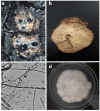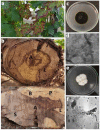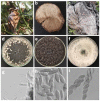A Panoramic View on Grapevine Trunk Diseases Threats: Case of Eutypa Dieback, Botryosphaeria Dieback, and Esca Disease
- PMID: 35736078
- PMCID: PMC9224927
- DOI: 10.3390/jof8060595
A Panoramic View on Grapevine Trunk Diseases Threats: Case of Eutypa Dieback, Botryosphaeria Dieback, and Esca Disease
Abstract
Grapevine trunk diseases (GTD) are currently one of the most devastating and challenging diseases in viticulture, leading to considerable yield losses and a remarkable decline in grapevine quality. The identification of the causal agents is the cornerstone of an efficient approach to fighting against fungal diseases in a sustainable, non-chemical manner. This review attempts to describe and expose the symptoms of each pathology related to GTD, the modes of transmission, and the harmfulness of recently reported agents. Special attention was given to new diagnostic tests and technologies, grapevine defense mechanisms, molecular mechanisms of endophytes fungal colonization, and management strategies used to control these threats. The present extended review is, therefore, an updated state-of-the-art report on the progress in the management of vineyards.
Keywords: biological control; fungus; phytosanitary problems; vine.
Conflict of interest statement
The authors of this work declare no conflicts of interest.
Figures





Similar articles
-
Microbial Biological Control of Fungi Associated with Grapevine Trunk Diseases: A Review of Strain Diversity, Modes of Action, and Advantages and Limits of Current Strategies.J Fungi (Basel). 2023 May 31;9(6):638. doi: 10.3390/jof9060638. J Fungi (Basel). 2023. PMID: 37367574 Free PMC article. Review.
-
Diversity Profiling of Grapevine Microbial Endosphere and Antagonistic Potential of Endophytic Pseudomonas Against Grapevine Trunk Diseases.Front Microbiol. 2020 Mar 26;11:477. doi: 10.3389/fmicb.2020.00477. eCollection 2020. Front Microbiol. 2020. PMID: 32273871 Free PMC article.
-
A Systematic Survey on Prevalence of Grapevine Trunk Disease Pathogens in Oregon Vineyards.Plant Dis. 2023 May;107(5):1355-1364. doi: 10.1094/PDIS-05-22-1220-RE. Epub 2023 May 17. Plant Dis. 2023. PMID: 36089679
-
Secreted proteins produced by fungi associated with Botryosphaeria dieback trigger distinct defense responses in Vitis vinifera and Vitis rupestris cells.Protoplasma. 2018 Mar;255(2):613-628. doi: 10.1007/s00709-017-1175-z. Epub 2017 Oct 17. Protoplasma. 2018. PMID: 29043572
-
Fungal Grapevine Trunk Diseases in Romanian Vineyards in the Context of the International Situation.Pathogens. 2022 Sep 2;11(9):1006. doi: 10.3390/pathogens11091006. Pathogens. 2022. PMID: 36145437 Free PMC article. Review.
Cited by
-
In Vitro Evaluation of Some Endophytic Bacillus to Potentially Inhibit Grape and Grapevine Fungal Pathogens.Plants (Basel). 2023 Jul 5;12(13):2553. doi: 10.3390/plants12132553. Plants (Basel). 2023. PMID: 37447114 Free PMC article.
-
Pruning Wound Protection Products Induce Alterations in the Wood Mycobiome Profile of Grapevines.J Fungi (Basel). 2023 Apr 19;9(4):488. doi: 10.3390/jof9040488. J Fungi (Basel). 2023. PMID: 37108942 Free PMC article.
-
First Description of Non-Enzymatic Radical-Generating Mechanisms Adopted by Fomitiporia mediterranea: An Unexplored Pathway of the White Rot Agent of the Esca Complex of Diseases.J Fungi (Basel). 2023 Apr 21;9(4):498. doi: 10.3390/jof9040498. J Fungi (Basel). 2023. PMID: 37108951 Free PMC article.
-
Transcriptome profiling of symptomatic vs. asymptomatic grapevine plants reveals candidate genes for plant improvement against trunk diseases.BMC Plant Biol. 2025 Jul 2;25(1):811. doi: 10.1186/s12870-025-06763-9. BMC Plant Biol. 2025. PMID: 40604403 Free PMC article.
-
Development of a Multiplex PCR Assay to Detect Neofusicoccum parvum and Botryosphaeria dothidea in Walnut.Curr Microbiol. 2024 Oct 29;81(12):432. doi: 10.1007/s00284-024-03954-9. Curr Microbiol. 2024. PMID: 39472323
References
-
- OIV . State of the World Vitivinicultural Sector in 2020. International Organisation of Vine and Wine; Paris, France: 2021. pp. 1–19.
-
- Gorton L. Through the Grapevine: Tracing the Origins of Wine. The Ohio State University; Columbus, OH, USA: 2014.
-
- DRA . DRA; Perth, Australia: 2019. La Culture de la Vigne au Maroc. La Direction Régionale de l’Agriculture Méknes.
-
- García R.A.A., Revilla E. Agricultural and Biological Sciences. The Mediterranean Genetic-Code-Grapevine and Olive. IntechOpen; London, UK: 2013. The current status of wild grapevine populations (Vitis vinifera ssp sylvestris) in the Mediterranean basin; pp. 51–72.
Publication types
LinkOut - more resources
Full Text Sources

